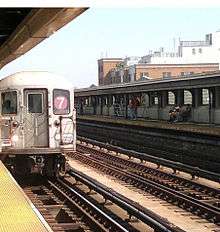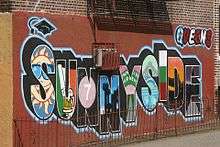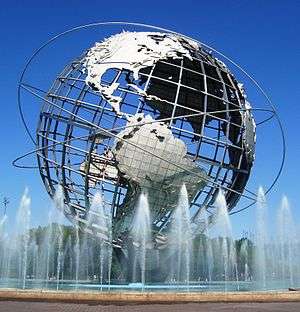Sunnyside, Queens
| Sunnyside | |
|---|---|
| Neighborhoods of Queens | |
|
The gantry over 46th Street at Queens Boulevard is located in the heart of Sunnyside | |
|
Location within New York City | |
| Country |
|
| State |
|
| City |
|
| County/Borough |
|
| Community District | Queens 2[1] |
| Named for | Sunnyside Hill Farms |
| Population | |
| • Total | 29,506 |
| ZIP code | 11104 |
| Area code(s) | 718, 347, 929, and 917 |
| Website |
www |
Sunnyside is a middle-class neighborhood in the Western portion of the New York City borough of Queens. It shares borders with Hunters Point and Long Island City to the west, Astoria to the north, Woodside to the east and Maspeth to the south. The neighborhood is part of Queens Community District 2, served by Queens Community Board 2.[2] The neighborhood's boundaries correspond roughly with those of ZIP code 11104, an area of nearly 0.5 square miles (1.3 km2) with a population of around 27,000. It contains the Sunnyside Gardens Historic District, one of the first planned communities in the United States.[3]
The name "Sunnyside" originates with the Bragaw family, French Huguenots who had purchased the land in 1713 and named their estate "Sunnyside Hill".[4][5] Sunnyside was a rural hamlet mostly consisting of small farms and marshland. It was incorporated into Long Island City in 1870, and developed into a bedroom community after the Queensboro Bridge was completed in 1909. A large portion of the neighborhood is six-story apartment buildings constructed during the 1920s and 1930s.
Sunnyside Gardens subsection
|
Sunnyside Gardens Historic District | |
 A typical brick row house along 39th Avenue. | |
 Location in New York City  Sunnyside, Queens (New York)  Sunnyside, Queens (the US) | |
| Location | Roughly bounded by Queens Blvd., 43rd and 52nd Sts. Barnett and Skillman Aves., New York, New York |
|---|---|
| Coordinates | 40°44′49″N 73°55′3″W / 40.74694°N 73.91750°W |
| Area | 53 acres (21 ha) |
| Built | 1924 |
| Architect | Stein, Clarence; Wright, Henry |
| Architectural style | Colonial Revival, Art Deco |
| NRHP reference # | [6] |
| Added to NRHP | September 7, 1984 |
Sunnyside Gardens, listed as a historic district on the National Register of Historic Places,[4][7] is among the first planned communities in the U.S.
Sunnyside Gardens includes one-, two-, and three-family homes, and a few apartment buildings, all made of Hudson brick (it was inexpensive, durable, and available). Each private residence has a small front garden facing the street and a private garden in the rear. The rental units in the two- and three-family houses enjoy private terraces overlooking the gardens. There are two configurations: the courtyard condition and the mews condition; at the edges of the community some homes simply line the street, with a common walkway running the length of the row. Homes in the courtyard blocks enclose an inner courtyard that was designated a common, landscaped but not used for recreation. Each homeowner actually owned, and paid taxes on, the part of the common in the block and lot, even if it was not used. The mews houses face a common front court and back on alleys; each mews house also has a private rear yard.
This model allowed for denser residential development, while also providing ample open/green-space amenities. Clarence Stein and Henry Wright served as the primary architects and planners for this development (Frederick L. Ackerman designed some of the mews houses), and the landscape architect was Marjorie Sewell Cautley. As an amenity for the residents, the City Housing Corporation reserved lots on the northern edge of the development abutting the railroad yards for a private park. This is one of only two private parks in the city, the other being Gramercy Park. These well-planned garden homes are now listed as a historic district.[8][9]
Early history
The area was the first development in the United States patterned after the ideas of the garden city movement initiated in England in the first decades of the twentieth century by Ebenezer Howard and Raymond Unwin, specifically Hampstead Garden Suburb and Letchworth Garden City. Covering 77 acres between Queens Boulevard and the Sunnyside Railroad Yards, Sunnyside Gardens was constructed between 1924 and 1928 by the City Housing Corporation, founded by developer Alexander Bing, and architects Clarence Stein and Henry Wright. The project grew out of discussions in the early 1920s about housing and planning; Lewis Mumford was a leading participant.
In the early years of the Great Depression, nearly 60 percent of the residents lost their homes to foreclosure.[10] Those difficult years saw organized resistance by residents who forcefully resisted efforts by city marshals to evict families. The character of Sunnyside Gardens was protected by 40-year easements which protected the integrity of the courtyards and common walkways and controlled changes to the exterior of every property, extending to even paint color. Those covenants lapsed in the mid-1960s, and some homeowners rushed to claim their property, erecting fences into the middle of some courtyards. In response, in 1974 the Department of City Planning designated Sunnyside Gardens a special planned community preservation district, together with Fresh Meadows, Parkchester, and the Harlem River Houses. With that designation came rules protecting the inner courts and landscaping, and prohibiting driveways and curbcuts, rear sheds, and additions.
Sunnyside Gardens Historic District
The Sunnyside Gardens Historic District is a national historic district that includes 66 contributing buildings and 12 contributing sites.[11] It was listed on the National Register of Historic Places in 1984.[6]
Sunnyside Gardens is a park that takes up approximately three and a half acres, also known as a New York City landmark. It was built between 1924 and 1928, roughly taking up 16 blocks, which consists more than 600 buildings. It has 12 courts within the landmark, which are known as Carolin Gardens, Colonial Court, Hamilton Court, Hamilton Court Apartments, Harrison Place, Jefferson Court, Lincoln Court, Madison Court North and South, Monroe Court Apartments, Phipps Garden Apartments I, Phipps Garden Apartments II, Roosevelt Court, Washington Court, and the Wilson Court.[12] Sunnyside Gardens is located in the Northwestern part of Queens which was established by Clarence Stein, Henry Wright and the City Housing Corporation were led by Alexander Bing.[13] The creators of the Sunnyside Gardens wanted to create housing which would be inexpensive to residents to stop the shortages and overcrowding of other areas.
In 2003, a grassroots movement started to request designation as a New York City Historic District, in response to lack of protection for the historic character of the homes in the neighborhood. The campaign was surprisingly contentious and garnered publicity in major news outlets, including WNYC and the New York Times. On April 17, 2007, the Landmarks Preservation Commission held a public hearing on the neighborhood; 60 residents and advocates, including Fiona Lowenstein, a descendant of Henry Wright spoke in favor of landmark designation while 25 people spoke against. According to the New York Times, Sunnyside Gardens is a "Pocket of Queens Brimming with History and Now Resentment".[14] This was documented on New York Public Radio in a segment called "Cloud Over Sunnyside?".[15] On June 26, 2007, the Landmarks Preservation Commission voted to designate the community.
Before designation there was considerable illegal or simply inappropriate work done on houses. Since designation, there has been a noticeable drop in work done without Department of Buildings permits, and many homeowners have restored their properties under the standards set by the Landmarks Commission. One project converting a two-family house into a single-family residence was awarded an award by the New York State chapter of the AIA.[16] Gradually the district is returning to its original character.
Demographics
Queens is one of the most ethnically diverse urban areas in the world.[17] Sunnyside's residents are also ethnically diverse and include people of Albanian, Algerian, Armenian, Bangladeshi, Bulgarian, Burmese, Chinese, Colombian, Dominican, Ecuadorian, Egyptian, Filipino, French, Greek, Indian, Iraqi, Irish, Israeli, Italian, Japanese, Korean, Lebanese, Mexican, Moroccan, Nepali, Pakistani, Paraguayan, Peruvian, Puerto Rican, Romanian, Russian, Salvadoran, Thai, Tibetan, Turkish and Vietnamese ancestry. According to the 2010 United States Census, Sunnyside (and neighboring Woodside) are 35% Hispanic, 34% Asian, 28% White, 2% Black and 2% Other.[18][19] Sunnyside has a variety of ethnic cuisine, which is showcased during an annual springtime food festival called Taste of Sunnyside where people can sample cuisines from local restaurants.[20]
The median household income for Sunnyside is $55,294 USD. The mean household income for Sunnyside is $70,828 USD. As of 2015, there were 121,039 people currently residing in Queens Community Board 2.[18][19]
Schools
Public services
The precinct keeping the Sunnyside community safe is the 108th Precinct. The precinct also protects Woodside and Long Island City. The 108th precinct includes Sunnyside beginning from 37 Street through the East to 52nd Street. Crime from 1933 to 2015, a 22-year range, has decreased abundantly in Sunnyside. One murder has occurred up to date in the year of 2015, where 16 murders took place in 1990. In the year 1990, the total of crimes which included murder, rape, robbery, felony assault, burglary, grand larceny, and grand larceny auto (G.L.A) was 7,857 (NYPD 108th Precinct, 2015). In the year 2014, the total amount of crimes that happened was 1,278. In total, the number of crimes that occurred in Sunnyside from 1990 to 2014 has decreased 83.7 percent. Crimes in Sunnyside-Woodside have decreased over the years, which allows residents to feel more safe in their homes and neighborhood.[21]
Other services include:
- Fire Department – Engine 325, Hook & Ladder 163 – "Woodside Warriors", FDNY – 41-24/26 51st Street
- Sanitation Department - Queens West 2 District - 52-35 58th St. By 53rd Ave. & East of 58th St. – Woodside, NY 11377
- Sunnyside Post Office – 45-15 44th Street
- Sunnyside Branch of Queens Borough Public Library – 43-06 Greenpoint Avenue
- Sunnyside Community Services - 43-31 39th Street
- Sunnyside Chamber of Commerce
Parks
Transportation

Sunnyside is served by the 7 train on the New York City Subway's IRT Flushing Line, with 33rd Street – Rawson Street, 40th Street – Lowery Street, and 46th Street – Bliss Street in Sunnyside. The Q32, Q39, Q60, Q104, B24 buses run through Sunnyside.
The area has easy access to Manhattan via the Long Island Expressway and the Queens Midtown Tunnel and to Brooklyn via the Brooklyn-Queens Expressway.
Sunnyside is also known for the former Pennsylvania Railroad (now Amtrak) railyard known as Sunnyside Yard. It is a staging area for both Amtrak and New Jersey Transit trains leaving from Penn Station. The proposed East Side Access project will include a new Long Island Rail Road train station in Sunnyside at Queens Boulevard along the LIRR's Main Line (into Penn Station) will provide one-stop access for area residents to Midtown Manhattan and Grand Central Terminal.[22]
Notable people

Notable celebrities include Johanna Magdalena Beyer, Perry Como, Nancy Walker, Benh Zeitlin, David Horowitz, Judy Holliday,[23] Joe Spinell, James Caan and Rudy Vallee;[24] artist Raphael Soyer, and writers and social activists such as Lewis Mumford and Suze Rotolo.The Queens-grown punk rock group The Ramones played some of their earliest gigs in Sunnyside pubs during the 1970s.. In the years before World War II New York Giants star Hap Moran coached a youth football team, the Mustangs, in Sunnyside Park.[25] William Patrick Stuart-Houston, the nephew of Adolf Hitler, lived in Sunnyside for a brief period of time before leaving for the U.S. Navy in 1944. Former pro wrestler Chris Kanyon came from Sunnyside. Legendary jazz musician Bix Beiderbecke died at 43–30 46th Street in Sunnyside, and a plaque was erected in his honor by the Greater Astoria Historical Society.[26]
In film and TV
Notable films shot in the area include:
- The Believer
- The Opportunists
- Queen of Media
- Raising Helen
- Sleepers
- Spider-Man (some exterior scenes)
- Spider-Man: Homecoming
Several television shows have shot scenes in the neighborhood, including:
See also

References
- ↑ "NYC Planning | Community Profiles". communityprofiles.planning.nyc.gov. New York City Department of City Planning. Retrieved 7 April 2018.
- ↑ Queens Community Boards, New York City. Accessed September 3, 2007.
- ↑ Haller, Vera (2015-03-18). "Sunnyside, Queens, 'Mayberry' Near Midtown". The New York Times. ISSN 0362-4331. Retrieved 2017-10-25.
- 1 2 "Sunnyside" on Forgotten NY Neighborhoods
- ↑ Wilkinson, Christina (September 12, 2005). "Sunnyside, Queens". Forgotten New York.
- 1 2 National Park Service (2009-03-13). "National Register Information System". National Register of Historic Places. National Park Service.
- ↑ Vitullo-Martin, Julia (2005-07-07). "A Pioneering Queens Garden Community Flourishes Anew". New York Sun. Retrieved 2010-01-17.
- ↑ Community and Library History, Queens Borough Public Library. Accessed February 14, 2008.
- ↑
- Konigsberg, Eric (June 19, 2008). "The Guardian of Gramercy Park". New York Times. Retrieved 2014-12-07.
Gramercy is one of two private parks in New York City (the other, in Queens, is Sunnyside Gardens Park) and a key is required not only to enter, but to leave through a gate in its wraparound wrought-iron fence.
- "Sunnyside" on Forgotten NY
- Vitullo-Martin, Julia. "A Pioneering Queens Garden Community Flourishes Anew" New York Sun (July 7, 2005)
- Konigsberg, Eric (June 19, 2008). "The Guardian of Gramercy Park". New York Times. Retrieved 2014-12-07.
- ↑ Kroessler, Jeffrey A., Building Queens: the urbanization of New York's largest borough. Ph.D. dissertation, CUNY Graduate School, 1991.
- ↑ Merrill Hesch (August 1984). "National Register of Historic Places Registration: Sunnyside Gardens Historic District". New York State Office of Parks, Recreation and Historic Preservation. Retrieved 2011-01-16. See also: "Accompanying 24 photos".
- ↑ "History". Sunnyside Gardens. Retrieved 2017-05-18.
- ↑ kkirvin. "SUNNYSIDE GARDENS, Borough of Queens Sunnyside Gardens, in northwestern Queens, was the creation of architects Clarence Stein an" (PDF). webcache.googleusercontent.com. Archived from the original (PDF) on February 12, 2017. Retrieved May 18, 2017.
- ↑ Barry, Ellen (2007-07-05). "A Pocket of Queens Brimming With History, and Now Resentment". The New York Times. Retrieved 2010-01-17.
- ↑ "Cloud over Sunnyside?". WNYC. Retrieved April 24, 2016.
- ↑ heimarchitect.com
- ↑ Colangelo, Lisa L. (2009-07-12). "Queens one of 'most diverse places on Earth,' new figures show". New York Daily News. Retrieved 2018-08-01.
- 1 2 "American Community Survey 5-Year Estimates". U.S. Census Bureau. Retrieved April 26, 2017.
- 1 2 "WOODSIDE AND SUNNYSIDE (Including Blissville, Hunters Point, Long Island City, Sunnyside, Sunnyside Gardens and Woodside)" (PDF). nyc.gov. NYC Health. 2015. Retrieved October 4, 2016.
- ↑ http://www.sunnysideshines.org/taste-sunnyside
- ↑ "108th Precinct - NYPD". www1.nyc.gov. Retrieved 2017-05-18.
- ↑ Vandam, Jeff. "An Enclave at Once Snug and Inclusive", The New York Times, February 4, 2007. Accessed February 14, 2008. "When the Long Island Rail Road's East Side Access project is completed in 2013, its trains, too, will go to Grand Central. Sunnyside's new station in the system will create a nonstop commute to Midtown."
- ↑ Shepard, Richard F. "Memories of My Queens", The New York Times, September 3, 1995. Accessed October 19, 2007. "My earliest memories are of Sunnyside, about 1929 and 1930, when my family moved to Queens and bought a house in Sunnyside Gardens, on what was then called Locust Street. Our next-door neighbors were a family by the name of Tuvim, whose daughter was to become a star of Broadway and Hollywood named Judy Holliday, although as a younger-than-teen-age Queens girl she gave little evidence of such talent."
- ↑ "Spare Times", The New York Times, October 12, 2001. Accessed October 19, 2007. "Hometown NYC: Sunnyside, Queens. A tour of the area that was once home to Rudy Vallee, led by Saul Bennett, a poet who was raised in the neighborhood."
- ↑ "Hap Moran". Retrieved April 24, 2016.
- ↑ "Solo in Sunnyside; Frank Gray travels through Queens, New York, in search of the late Bix Beiderbecke." The Guardian, April 30, 2005.
External links
| Wikimedia Commons has media related to Sunnyside, Queens. |
- Sunnyside Chamber of Commerce
- New York Metro: 6 Affordable Neighborhoods – Sunnyside
- NYTimes: An Enclave at Once Snug and Inclusive
- Greater Astoria Historical Society
- Sunnyside Post, local news site for Sunnyside residents
- Sunnyside Neighborhood on Queens Buzz
Sunnyside Gardens
- A Fact Sheet for Residents from the NYC Department of City Planning, Queens Office dated June 2002
- WNET Channel 13 profile of Sunnyside Gardens
- July 23, 2003 Article about Landmarks Meeting
- Queens Buzz Sunnyside Queens cultural web magazine
